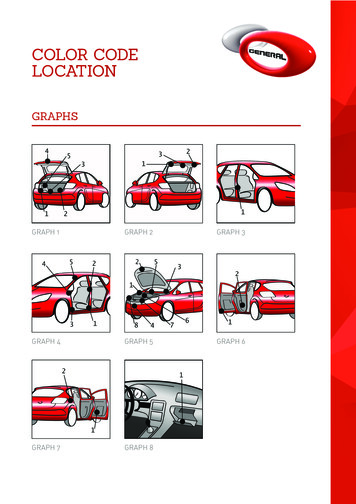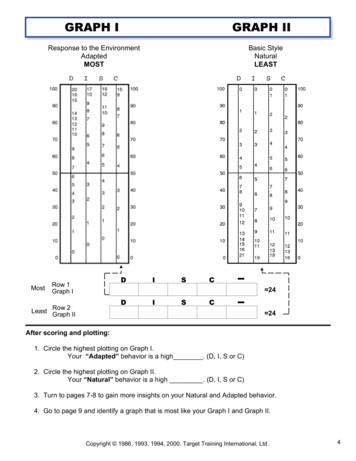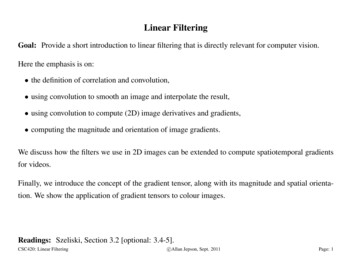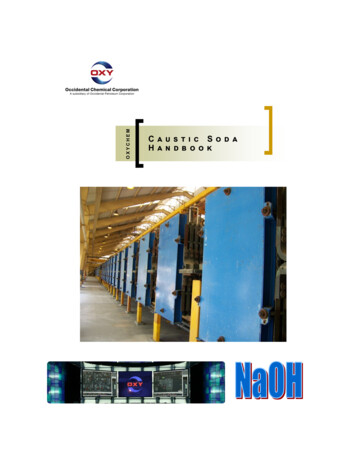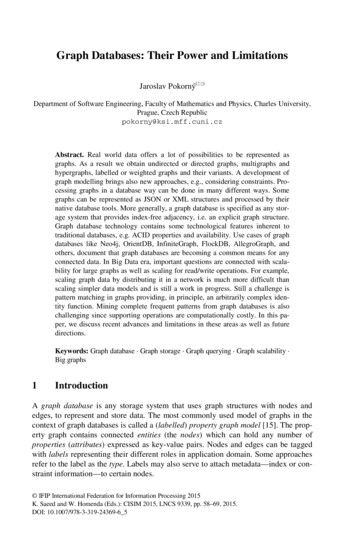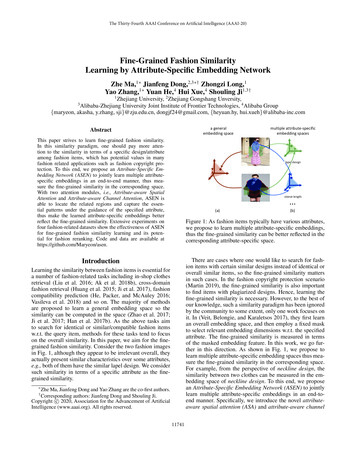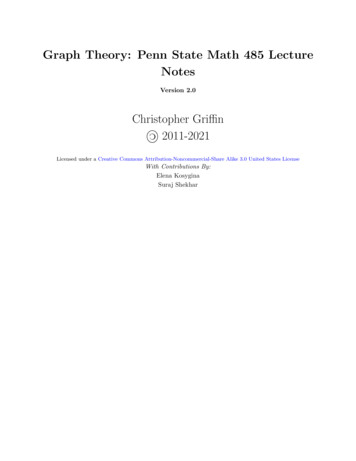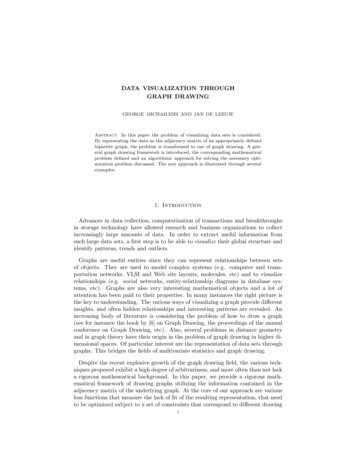
Transcription
Proceedings of the Twenty-Ninth International Joint Conference on Artificial Intelligence (IJCAI-20)Multi-View Attribute Graph Convolution Networks for ClusteringJiafeng Cheng1 , Qianqian Wang1 , Zhiqiang Tao2 , Deyan Xie1 and Quanxue Gao1,3†1State Key Laboratory of Integrated Services Networks, Xidian University2Northeastern University3Unmanned System Research Institue, Northwestern Polytechnical universityxd.jiafengcheng@gmail.com, qianqian174@foxmail.com, {zqtaomail, Graph neural networks (GNNs) have made considerable achievements in processing graph-structureddata. However, existing methods cannot allocatelearnable weights to different nodes in the neighborhood and lack of robustness on account of neglecting both node attributes and graph reconstruction. Moreover, most of multi-view GNNs mainlyfocus on the case of multiple graphs, while designing GNNs for solving graph-structured data ofmulti-view attributes is still under-explored. Inthis paper, we propose a novel Multi-View Attribute Graph Convolution Networks (MAGCN)model for the clustering task. MAGCN is designedwith two-pathway encoders that map graph embedding features and learn view-consistency information. Specifically, the first pathway develops multiview attribute graph attention networks to reducethe noise/redundancy and learn the graph embedding features of multi-view graph data. The secondpathway develops consistent embedding encodersto capture the geometric relationship and the consistency of probability distribution among different views, which adaptively finds a consistent clustering embedding space for multi-view attributes.Experiments on three benchmark graph databasesshow the effectiveness of our method comparedwith several state-of-the-art algorithms.1IntroductionMulti-view clustering is a fundamental task in machine learning. It aims to integrate multiple features and discover consistent information among different views [Xie et al., 2019;Li et al., 2019; Zhang et al., 2018a]. Existing multi-viewclustering methods have achieved considerable results in theEuclidean domains [Andrew et al., 2013; Gao et al., 2020].However, those algorithms are no longer suitable for processing intensively studied data, which often occurs in the nonEuclidean domains such as graphs in social network connections, article citations, etc. In light of this, graph embedding †Corresponding AuthorCorresponding Author2973methods, which could effectively explore the graph structureddata, have received much attention recently.Graph embedding converts graph data into a lowdimensional, compact, and continuous feature space, whichis usually implemented by matrix-factorization [Belkin andNiyogi, 2002], random-walk [Perozzi et al., 2014], or graphneural networks (GNN) [Salehi and Davulcu, 2019; Kipf andWelling, 2017]. Among existing methods, GNNs, largelyowing to their efficiency and inductive learning capability[Hamilton et al., 2017], have become one of the most popular paragons. Generally, GNNs calculate the embedding ofa graph node by applying multiple graph convolutional layersto gather the information of node neighbors through nonlineartransformations and aggregation functions. Hence, they canpreserve the topological structure, vertex content informationof the graph-structured data. Although the above GNNs caneffectively process single-view graph data, they are not applicable to multi-view graph data.To tackle this challenge, some research attempts are madein using GNNs for multi-view data of multiple graph structures. For example, multi-view graphs are used for prediction and classification of drug similarity and medicine in themedical filed [Zhang et al., 2018b; Ma et al., 2018], and arealso leveraged for ridehailing demand forecasting and globalpoverty [Geng et al., 2019; Khan and Blumenstock, 2019].However, those multi-view graph neural networks have thefollowing limitations: 1) They cannot allocate learnable specifying different weights to different nodes in neighborhood;2) They may neglect to proceed the reconstruction of bothnode attributes and graph structure to improve the robustness;3) The similarity distance measure is not explicitly considered for the consistency relationship among different views.Moreover, existing multi-view GNN methods mainly focuson the case of multiple graphs, while ignoring equally important attribute diversity, i.e. multi-attribute. Nonetheless, in thereal world, it is common that we have multiple characteristicattributes with the same connection relationship of a graph.For instance, people could have multiple attributes, such as,job, hobby, etc., in the connection graph of social network.Motivated by the above observations, in this paper, we propose a novel Multi-view Attribute Graph Convolution Networks for clustering (MAGCN) the graph-structured data ofmulti-view attributes (see Fig.2). Specifically, 1) to allocate learnable weights to different nodes, MAGCN devel-
Proceedings of the Twenty-Ninth International Joint Conference on Artificial Intelligence (IJCAI-20)12 m (l )m i1xCommonGraphxxmi ( )AView mXmˆXmliixmnA group ofsunflowers in thesunshineA group ofsunflowers in thesunshineˆAmh1 ( )hm(l ) inHm1l2( l )1i ( l ) ( l 1)h( l 1) i1hmi ( iil 1)( l 1) inh1 ( )n l1ˆ1(l )xˆm2 xˆm ˆ ( ) ˆ 2(l )h1 ˆ (h1xˆli1l 1)i1i ( l ) ˆ i ( l ) ( l 1) ˆi ( l 1)hmhm ˆiim ˆii(l ) ˆin(l 1)n ˆinhˆ1n(l )mxˆInner Product DecoderFigure 1: Part of Multi-view Attribute Graph Convolution Encoderfor view m.ops multi-view attribute graph convolution encoders withattention mechanism for learning graph embedding frommulti-view graph data. 2) Attribute and graph reconstruction are both computed by the graph convolution decodersof MAGCN. 3) The geometric relationship and the probability distribution consistency among multi-view graph dataare incorporated into the consistent embedding encoders ofMAGCN to further facilitate the clustering task. The key contributions of our work are summarized as follows. We propose a novel Multi-View Attribute Graph Convolution Networks for clustering on the graph-structureddata of multi-view attributes. We develop multi-view attribute graph convolutionencoders with attention mechanism to reduce thenoise/redundancy of the multi-view graph data. In addition, reconstruction of both node attributes and graphstructure are considered to improve the robustness. Consistent embedding encoders are designed to extractthe consistency information among multiple views, byexploring the geometric relationship and the probabilitydistribution consistency of different views.2Related WorkLearning graph node embedding within broader graph structure is crucial for many tasks on graphs. Existing GNNsmodels in processing graph-structured data belong to a setof graph message-passing architectures that use different aggregation schemes for a node to aggregate feature messagesfrom its neighbors in the graph. Graph Convolutional Networks [Kipf and Welling, 2017] scale linearly in the number of graph edges and learn hidden layer representationsthat encode both local graph structure and features of nodes.By stacking self-attention layers in which nodes are able toattend over their neighborhoods’ features, Graph AttentionNetworks (GAT) [Velickovic et al., 2018] enable specifyingdifferent weights to different nodes in neighborhood. GraphSAGE [Hamilton et al., 2017] concatenates the node’s featurewith diversified pooled neighborhood information and effectively trades off performance and runtime by sampling nodeneighborhoods. Message Passing Neural Networks [Gilmer2974et al., 2017] further incorporate edge information when doing the aggregation.To handle the problem of multi-view graph node embedding, some researchers have made some attempts. In the medical field, [Zhang et al., 2018b] propose a method based onGCNs for fusing multiple modalities of brain images in relationship prediction, which is useful for distinguishing Parkinson’s Disease cases (a prevalent neurodegenerative disease)from controls. Another novel model [Geng et al., 2019],called spatiotemporal multi-graph convolution network, encodes the non-Euclidean correlations among regions usingmultiple graphs and explicitly captures them using multigraph convolution encoder. In application accounting for social networks, Multi-GCN [Khan and Blumenstock, 2019] incorporates non-redundant information from multiple viewsinto the learning process. [Ma et al., 2018] utilize multiview graph auto-encoder, which integrates heterogeneous,noisy, nonlinear-related information to learn accurate similarity measures especially when labels are scarce.However, those multi-view GNNs cannot allocate learnable specifying different weights to different nodes in neighborhood, where we can learn from the excellent ideas ofGAT. And the clustering performance of them is limited asthey do not consider the structure and distribution consistencyfor clustering embedding. What’s more, GNNs for solvinggraph-structured data of multi-view attributes is still underexplored. Existing multi-view GNNs mainly focus on thecase of multiple graphs and neglect the equally important attribute diversity. Thus, in this paper, we propose MAGCN onmulti-view attribute graph data.33.1Proposed MethodologyNotationA graph can be represented as G (V, E)(G Rn n ),where V {v1 , v2 , ., vn } is the node set and E is the edgeset, n denotes the number of nodes, and vi represents the i-thnode. In this study, we augment graph G with the node mth view attribute feature Xm {x1m , ., xim , ., xnm }(Xm Rn dm ), m 1, 2, ., M , where xim refers to the featurevector associated with node vi and M is the number of views.3.2The Framework of MAGCNAs shown in Fig.2, our model contains two principlemodules: multi-view attribute graph convolution Encodersand consistent embedding Encoders.We first encodemulti-view graph data Xm into graph embedding Hm {h1m , ., him , ., hnm }(Hm Rn d ) by multi-view attributegraph convolution encoders. Then, fed Hm into consistentembedding encoders and obtain a consistent clustering embedding Z. The clustering process is eventually conductedon the ideal embedding intrinsic description space which iscomputed by Z.Multi-view Attribute Graph Convolution EncoderIn multi-view attribute graph convolution encoders, the firstpathway encoders map multi-view node attribute matrix andgraph structure into graph embedding space. Specifically, forthe m-th view, the function of a graph embedding model is
Proceedings of the Twenty-Ninth International Joint Conference on Artificial Intelligence (IJCAI-20)View 1 DistributionInner ProductDecoderĜ1Q1X̂1View 1Z1H1Geometric RelationshipConsistencyX1ZCommon GraphMulti-view AttributeGraph ConvolutionEncodersGGraph EmbeddingFIdeal DistributionPClustering EmbeddingA group ofsunflowers in thesunshineProbability DistributionConsistencyHmReconstructed ViewˆXmReconstructed Graph2Consistent EmbeddingEncodersView mXmZi Z jFully Connected LayerGraph Convolution DecoderˆGmP Qi2FZmQmInner ProductDecoderView m DistributionFigure 2: The framework of Multi-View Attribute Graph Convolution Networks for Clustering (MAGCN). It contains two key components:1) Multi-view attribute graph convolution encoders with attention mechanism: they are used to learn graph embedding from node attributeand graph data. Attribute and graph reconstruction are executed for end-to-end learning. 2) Consistent embedding encoders further obtain aconsistent clustering embedding among multiple views through geometric relationship and probability distribution consistency.fm (G, Xm ; θ) Hm . It maps graph G and m-th view attributes Xm to d-dimensional graph embedding features Hm ,where θ represents multi-view graph auto-encoder parameter. As shown in Fig.1, the output of l-th multi-view attributegraph convolution encoders is 0 12(l 1)(l) 12GDHW,(1)H(l) σDmmwhere G0 G IN is the relevance coefficient matrixwithself-connection. IN is the identity matrix, Dii P added0(l)is the trainable parameter of the l-th multij G ij and Wview auto-encoder layer and σ denotes the activation func(0)(l)tion. As for Hm , when l 0, Hm is the initial m-th view(L)attribute matrix Xm and when l L, Hm is the final graphembedding feature representation Hm .To determine the relevance between nodes and their neighbors, we use a attention mechanism with shared parametersamong nodes. In the l-th multi-view encoder layer, the learnable relevance matrix S is defined as (l)(l) (l)(l)S ϕ G ts(l) H(l)W GtHW, (2)mrmwhere ts (l) and tn (l) R1 dl represent the trainable parameters related to their own nodes and neighbor nodes, respectively.refers to the element-wise multiplication withbroadcasting capability, and ϕ denotes the activation functionwhich is generally set as the sigmoid activation function (i.e.,sigmoid (x) 1/ (1 exp x )). We normalize S to get thefinal relevance coefficient G, so Gij is computed byexp (Sij )Gij P.exp (Sik )(3)k NiAfter applying L multi-view encoder layers, we get graphembedding Hm which preserves basically all informationabout multi-view node attribute matrix X and graph structureG. Then, we consider the feature Hm that contains almost allthe information to decode as different views. In the decodingprocess, we use the same number of layers as encoders for decoders, and each decoder layer tries to reverse its corresponding encoder layer. In other words, the decoding process is theinverse of the encoding process. The final decoded output isreconstructed node attribute matrix X̂m and the reconstructedgraph structure Ĝm , m 1, 2, ., V . Specifically, the outputof the (l 1)-th multi-view attribute graph convolution decoders is 11(l)Ĥ(l 1) σ D̂ 2 Ĝ0 D̂ 2 Ĥ(l).(4)m ŴmAfter applying L decoder layers, reconstructed multi-view(0)node attribute matrix X̂m Ĥm is obtained. As for the reconstructed graph structure Ĝm , Ĝijm is implemented by aninner product decoder of him and hjm , where him and hjm arethe node i and j of graph embedding features Hm . Specifically, Ĝijm is computed by ijĜij(5)m φ( hm hm ),where φ(·) is the inner product operator.Finally, the reconstruction loss Lre of reconstructed multiview node attribute matrix X̂ and reconstructed graph structure Ĝ can be computed by following:Lre minθMXi 12Xi X̂iF λ1MXi 12G Ĝi,F(6)where θ is the network parameter of multi-view attributegraph convolution encoders.where Ni is the set of all nodes adjacent to node i.2975
Proceedings of the Twenty-Ninth International Joint Conference on Artificial Intelligence (IJCAI-20)Consistent Embedding EncodersIn consistent embedding encoders, for view m, we first adoptnonlinear feature extraction mapping for graph embeddingHm . Hm is mapped into low-dimensional space Zm . Themapping function is gm (Hm ; η) Zm , where η representsencoder parameter. Zm contains almost all the original information so that it is not suitable for multi-view integratingdirectly. Then, we use consistent clustering layer to learn acommon clustering embedding Z which is adaptively integrated by all the Zm .Assume Zm and Zb are the low-dimensional space featurematrices of view m and b obtained from consistent embedding encoders. Then we can use them to compute a geometric relationship similarity score as si(Zm , Zb ), where si(·)is a similarity function. si(·) can be measured by the Manhattan Distance, Euclidean distance, cosine similarity, etc. Ifthe simplest difference similarity function is taken, the lossfunction of geometric relationship consistency Lgeo isLgeo minηMX2kZi Zj kF .(7)i6 jwhere η is the network parameter of encoder.Besides the geometric relationship, we also consider theconsistency of the probability distribution between common representation Z and latent representation of each viewPMZm , where Z m 1 βi Zi is an adpative fusion on a lowdimensional feature space, Zm {z1 , ., zi , ., zn }(Zm Rn d ). We show the details of computing the probabilitydistribution of Z and Zm in the following.Following [Tao et al., 2019; Wang et al., 2018], we use theStudent’s t-distribution, , as a kernel to measure the similaritybetween integrated node representation zi and centroid µj .Thus, the original probability distribution Q of Z isqij P(1 zi µj 2 /α)j0 α 12(1 zi µj 0 2 /α) α 12,(8)where {µj }kj 1 is the k initial cluster centroids, α is the degree of freedom of the Student’s t-distribution, qij is the probability of assigning node i to cluster j. In our experiments, wecompute target probability distribution P of Z. pij is the elements of P, and 0 pij 1. By raising qi to its secondpower and normalizing it with the frequency per cluster asfollows, we obtainpij P2qij/fi,2j 0 qij 0 /fj 0(9)Pwhere fj i qij are soft cluster frequencies. To this end,we define our objective as a probability distribution consistency loss Lpro between the soft assignment Qm of Zm raCiteseerPubmed1, 4333, 7035002, 7083, 32719, 7177632, 7083, 32719, 7175, 4294, 73244, 438the auxiliary distribution P of Z with trade-off parameters ρas followsLpro minηMP2m 1ρm kQm PkF .(10)In this way, we could concentrate on the same class databy sharping the data distribution and get a more effective andcommon representation for multi-view clustering.3.3Task for ClusteringBy combining Eq. (6), Eq. (7) and Eq. (8), the total loss function of the proposed MAGCN is eventully formulated asL min Lre λ2 Lgeo λ3 Lpro .g,c,P(11)Optimizing the overall loss L, we learn the auxiliary distribution P from the clustering embedding feature Z. Then wepredict the cluster of each node from auxiliary distribution P.For node i, its cluster can be calculated by pi , in which the index with the highest probability value is the i’s cluster. Hencewe could obtain the cluster label of node i asyi arg max (pik ) .(12)k44.1Experimental AnalysisExperimental SettingMetrics and DatabasesIn order to evaluate the effectiveness of our proposed approach, we conduct extensive experiments on three citationnetwork databases (Cora, Citeseer and Pubmed) [Sen et al.,2008] with three evaluation metrics: clustering accuracy(ACC), normalized mutual information (NMI) and averagerand index (ARI), and the higher these indicators, the betterthe clustering effect. The general graph-structured databasecontains one graph and one attribute and there is no such realgraph-structured data with multi-view attributes at present.Due to the databases used in the experiments, the attributesof graph-structured data are 0, 1, which are discrete structuredand also one-sided described. So we make attributes continuous by changing the operation of that, for the purpose ofdescribing the graph structure more abundantly. Inspired bymulti-graph, which constructs another graph by themselves,we construct additional attribute views by original attributes.Specifically, we use Fast Fourier Transform (FFT), Gabortransform, Euler transform and Cartesian product to constructview 2 based on view 1. In Sec. 4.2, the results of each view 2are analyzed. Brief statistics of the three databases are shownin Table 1, where view 2 is constructed by Cartesian product.For other experiments, we construct from the first view basedon Cartesian product.Implementation DetailsIn our experiments, we used two layers of multi-view attribute graph convolution encoders for all three databases.For Cora database, node representation dimensions of thetwo layer are set as [512, 512]. As to the Citeseer database,node representation dimensions of the two layer are set asTable 1: The details for experimental databases.2976
Proceedings of the Twenty-Ninth International Joint Conference on Artificial Intelligence NMIARIACCNMIARIACCNMIARIK-means [MacQueen, 46Graph Encoder [Tian et al., 2014]Deep Walk [Perozzi et al., 2014]DNGR [Cao et al., 2016]M-NMF [Wang et al., 0.2100.2380.1530.0840.1840.2550.0590.058DCCA [Andrew et al., 2013]DCCA [Andrew et al., 2013]DCCAE [Wang et al., 2015]DCCAE [Wang et al., 2015]X1 &X2G&X1 &X2X1 &X2G&X1 0970.1220.2390.0400.0970.0920.186GAE [Kipf and Welling, 2016]VGAE [Kipf and Welling, 2016]MGAE [Wang et al., 2017a]ARGAE [Pan et al., 2018]ARVGAE [Pan et al., 2018]DAEGC [Wang et al., 2019]GATE [Salehi and Davulcu, 2910.0780.2780.299MAGCN-view 1MAGCN-view 2MAGCNG&X1G&X2G&X1 5390.6910.3210.2610.3310.3100.2270.321Table 2: Clustering results of various methods on three databases. Best results are highlighted in red and the suboptimal results are marked inblue. Info. means the input of different methods: G donates the graph structure, X1 and X2 represent the node feature of view 1 and view 2.Figure 3: Visualization the change of parameters λ2 and λ3 of geometric relationship consistency and probability distribution consistency.[2000, 512]. For Pubmed, the dimension of two-layer multiview attribute graph convolution auto-encoder is [128, 64]. Inintegrate-encoder, we use a fully connected layer in all threedatabases. We use non-linear activation function σ as Relufunction in the multi-view graph convolution auto-encoder.As for regular term coefficient λ1 , λ2 and λ3 , we set λ1 as1. λ2 and λ3 are set range from 10 2 to 102 , and analyzethe influence of parameters later in Sec. 4.2: Impact of LossCoefficient.Comparison AlgorithmsWe choose several state-of-the-art clustering compared algorithms as follows. node attribute: K-Means; graph structure: Graph Encoder, DeepWalk, denoisingautoencoder for graph embedding (DNGR) and modularized nonnegative matrix factorization (M-NMF); graph structure & node attribute: graph autoencoders (GAE) and variational graph auto-encoders(VGAE), marginalized graph autoencoder (MGAE), ad-2977versarial regularized graph autoencoder (ARGAE) andadversarial variational regularized graph autoencoder(ARVGAE), deep attentional embedding graph clustering (DAEGA) and graph attention auto-encoders(GATE); deep multi-view clustering: deep canonical correlation analysis (DCCA) and deep typical correlated autoencoder (DCCAE).4.2Experimental ResultsEvaluation Metrics with Comparison AlgorithmsTable 2 summarizes the comparative evaluation results onthree databases of Cora, CIteseer, and Pubmed. The proposed MAGCN clearly outperforms all the compared methods. Specifically, MAGCN improves on GCNs of single viewby a margin of more than 5% on Cora and Citeseer and morethan 1% on Pubmed, which indicates that it is effective to integrate different views with the consistency of geometric relationship and the probability distribution. From the suboptimalresults, we can see that our method also has a substantial im-
Proceedings of the Twenty-Ninth International Joint Conference on Artificial Intelligence (IJCAI-20)Epoch 50Epoch 5000.750.7PEpoch 10.65ACCNMIARIQ10.60.55Q20.50.450.4Figure 4: Visualization of the distribution Q1 , Q2 and P. The x-axiscarries the clusters, and y-axis informs Cluster Probability.provement in single-view graph clustering. Meanwhile, thesingle view graph convolution clustering methods: DAEGCand GATE, have relatively better clustering performance,which shows that attention mechanism aggregating neighborhood information according to trainable attention weightshelps improving clustering performance. In addition, deepmulti-view clustering methods achieve better performance byusing the graph structure information. This shows that thegraph structure information can make beneficial contributionto clustering. The performance of deep multi-view clusteringmethods is even worse than many single-view GCN clustering methods, which also indicates the excellence of GCN inprocessing graph structured data.Analysis of Probability Distribution ConsistencyTo illustrate the advantages of probability distribution consistency in our model, we conduct the following visual experiments on Cora database. We randomly select a samplefrom the third class and compute original probability distribution Qm for each view’s low dimensional representation Zmand the target probability distribution P for the common feature representation Z. Our goal is to get the ideal descriptionspace of multi-view. In terms of low-dimensional featuresZm , we use the consistency of probability distribution as constraint to reduce the differences between different views. Asshown in Fig.4, in the initial iteration, the random initialization makes the probability of each class basically similar, andit is impossible to find out which class the sample belongs to.But the probability in the third class increases with the number of iterations, and the probability distributions on Z, Z1and Z2 tend to be consistent, which indicates that the idealmulti-view description feature Z is learned gradually.Impact of ParametersThere are three regularization parameters in our model: λ1 ,λ2 and λ3 , and we use controlling variables method to analyze their impact. We keep the regular parameters λ1 of reconstruction loss unchanged and change the regular parameters λ2 and λ3 of geometric relationship consistency andprobability distribution consistency in the model. As shownin Fig.3, when λ2 is between 10 2 and 102 , the corresponding evaluation metrics ACC, NMI and ARI will largely remain the same. That explains that the model has a relativelygood clustering robustness on geometric relationship consistency. As for the regular term λ3 of probability distribution2978FFTCartesianGaborEulerView 1Figure 5: Metrics vs. different view 2 on Cora database.consistency, when λ3 was set as 10, the multi-view clusteringhas the best performance. When the value of λ2 is too large,the model clustering performance is not good. Therefore, weset λ3 of probability distribution consistency around 10 in theexperiment.Analyzing Different View 2Analyze the performance of our model when the second vieware constructed in different ways (FFT, Cartesian, Garbor, andEuler) on Cora database. To facilitate the comparison, we usethe view 1 as the baseline. We keep all parameters consistentto ensure the fairness of the experiments. As shown in Fig.5,we can see for all kind of view 2, the clustering results withtwo views is better than the case of single view 1 (markedby black line). In addition, the Cartesian product way worksthe better than other constructing ways for view 2 (markedby red line). This is why we construct the second view usingCartesian products in all the other experiments.5ConclusionsIn this paper, we propose a novel Multi-View Attribute GraphConvolution Networks for Clustering (MAGCN), a generallymethod to multi-view graph neural network. MAGCN is designed with dual encoders that reconstruct the extracted features in high dimension and integrate the low dimension consistent information. Multi-view attribute graph auto-encoderand consistent embedding encoder network successively reduce the noise and the difference among different views, andfinally get the ideal description space of multi-view attributegraph for clustering. Experimental results on the multi-viewgraph structure databases demonstrate the validity of ourmethod and perform superior advantages over several stateof-the-art algorithms.AcknowledgmentsThis work is supported by National Natural ScienceFoundation of China (Grant 61773302, 61906142,61906141), Initiative Postdocs Supporting Program (GrantBX20190262), China Postdoctoral Science Foundation(Grant 2019M653564, 2019M663642), National NaturalScience Foundation of Shaanxi Province (Grant 2020JZ-19,2020JQ-317, 2020JQ-327).
Proceedings of the Twenty-Ninth International Joint Conference on Artificial Intelligence (IJCAI-20)References[Andrew et al., 2013] Galen Andrew, Raman Arora, JeffBilmes, and Karen Livescu. Deep canonical correlationanalysis. In ICML, pages 1247–1255, 2013.[Belkin and Niyogi, 2002] Mikhail Belkin and ParthaNiyogi. Laplacian eigenmaps and spectral techniques forembedding and clustering. In NeurIPS, pages 585–591,2002.[Cao et al., 2016] Shaosheng Cao, Wei Lu, and QiongkaiXu. Deep neural networks for learning graph representations. In AAAI, pages 1145–1152, 2016.[Gao et al., 2020] Quanxue Gao, Zhizhen Wan, Ying Liang,Qianqian Wang, Yang Liu, and Ling Shao. Multi-viewprojected clustering with graph learning. Neural Networks,pages 335–346, 2020.[Geng et al., 2019] Xu Geng, Yaguang Li, Leye Wang,Lingyu Zhang, Qiang Yang, Jieping Ye, and Yan Liu.Spatiotemporal multi-graph convolution network for ridehailing demand forecasting. In AAAI, pages 3656–3663,2019.[Gilmer et al., 2017] Justin Gilmer, Samuel S Schoenholz,Patrick F Riley, Oriol Vinyals, and George E Dahl. Neuralmessage passing for quantum chemistry. In ICML, pages1263–1272, 2017.[Hamilton et al., 2017] Will Hamilton, Zhitao Ying, and JureLeskovec. Inductive representation learning on largegraphs. In NeurIPS, pages 1024–1034, 2017.[Khan and Blumenstock, 2019] Muhammad Raza Khan andJoshua E Blumenstock. Multi-gcn: Graph convolutionalnetworks for multi-view networks, with applications toglobal poverty. In AAAI, volume 33, pages 606–613, 2019.[Kipf and Welling, 2016] Thomas N. Kipf and Max Welling.Variational graph
In multi-view attribute graph convolution encoders, the first pathway encoders map multi-view node attribute matrix and graph structure into graph embedding space. Specifically, for the m-th view, the function of a graph embedding model is Proceedings of the Twenty-Ninth International Joint Conference on Artificial Intelligence (IJCAI-20) 2974

